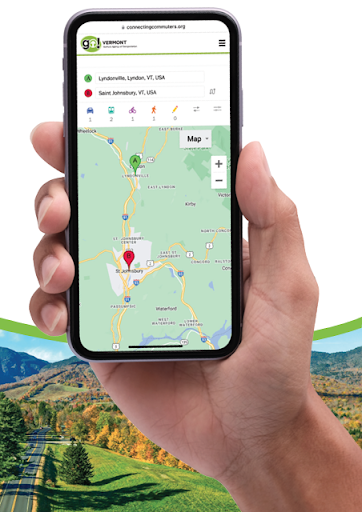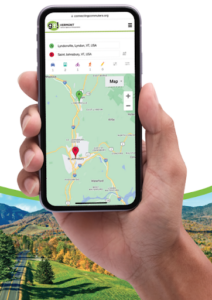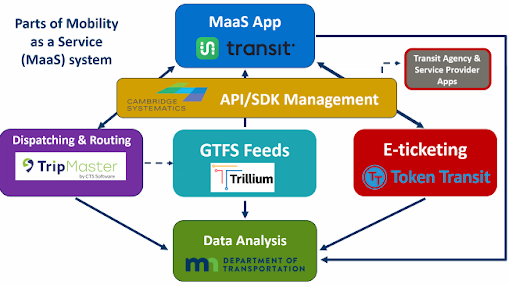Transit Innovation Workshop Series Workshop #2: How to Get From Here to There: Trip Planning Apps
10 minutes Author: Shared-Use Mobility Center Date Launched/Enacted: Feb 12, 2025 Date Published: April 3, 2025

Introduction
The American Association of State Highway and Transportation Officials (AASHTO) and the Shared-Use Mobility Center (SUMC) hosted the second virtual workshop of a four-part series on how State Departments of Transportation (DOTs) support innovation in shared mobility. These workshops are designed to build on each other to educate on the applications of innovative transit technologies. The February 2025 workshop explored mobility trip planning platforms, focusing on incorporating open data sources, procurement and partnership building, and how State DOTs can support projects to increase ridership in urban and rural communities.
Over 60 practitioners from State DOTs, technical assistance centers, and other organizations involved in this space joined to discuss how State DOTs are supporting urban and rural communities through the development and implementation of interoperable trip planning apps and web based platforms. Following introductions from AASHTO and SUMC and a discussion on the importance of collaboration within and across states, the workshop delved into the topic of trip planning, featuring two State DOT examples:
- Jeremy Whiting, Public Transit Program Coordinator from the Vermont Agency of Transportation (VTrans), discussed the Go Vermont program, highlighting its trip planner and stressing the importance of using open data to power applications.
- Elliott Mcfadden, Mobility Management Unit Supervisor (Interim) at Minnesota DOT (MnDOT), presented on the Minnesota Regional Mobility-as-a-Service (MaaS) platform, emphasizing the platform’s open architecture and use of data standards.
The virtual workshop concluded with a Q&A discussion.
Definitions
- A trip planning platform is a computer system that helps users plan trips by creating itineraries and routes, considering factors like distance, time, and available transportation options. Trip planning apps can be web-based and/or available through a smartphone.
- Interoperability refers to the ability of different transit systems and applications to effectively communicate and share data without barriers.
- An Application Programming Interface (API) is a system that connects computers or pieces of software to each other. APIs are software intermediaries that allow for the communication between different applications.
- Open data is data that can be freely used, re-used and redistributed by anyone with minimal restrictions – typically requiring only attribution and share-alike conditions.
- The Transactional Data Specification (TDS) is a data specification that addresses transactional details for booking, requesting, and scheduling demand-response services. For more information on the TDS, see Connecting Community Transportation: Lessons Learned from Transactional Data Specification Demonstration Projects and the accompanying Roadmap for Implementation.
- General Transit Feed Specification (GTFS) is a data standard that allows transit agencies to communicate fixed route transit service information to the public. GTFS is among the most widely used transportation data standards in the world.
- GTFS-Flex is a GTFS Schedule extension that includes on-demand flexible trips, such as dial-a-ride services, route deviation services, and point-to-zone services.
Major Takeaways
Open source data and interoperability are crucial to ensure systems can adapt
Using open source data gives agencies the ability to adapt and improve data accessibility in ways proprietary data cannot. Unlike proprietary data, open source data offers flexibility by enabling easy movement of data and allowing any provider to take over from another. For example, VTrans open data enables Transit App to display statewide public transportation options in real time. The Go! Vermont program demonstrates the value of open source data, by enabling third party vendors to utilize data and allowing for more efficient updates and modifications to accommodate new technologies. To avoid reliance on a single vendor, MnDOT separated API management from the consumer app and created an independent platform for managing these connections. Embracing open source data can create a more competitive and innovative environment that supports agency operations, avoiding vendor lock given the transit service data are not tied to a proprietary platform. To efficiently develop trip planning platforms, agencies can adopt an incremental approach, initially focusing on developing open data, followed by creating a trip planner that supports only one mode of transportation with plans to incorporate other modes later. Go! Vermont utilized this strategy by expanding GTFS Flex data and gradually integrating additional modes such as rideshare, commuter programs, and bikeshare.
State DOTs can help build capacity for small agencies
State DOTs can significantly enhance the capacity of smaller agencies that may lack the resources and expertise necessary to develop transit data and manage trip platforms. For example, DOTs may take on the responsibility of data management through statewide contracts with vendors, allowing agencies to focus on operations. MnDOT supports capacity building at smaller agencies by building partnerships to develop data feeds like GTFS Flex to manage on-demand flexible trips, such as dial-a-ride services, route deviation services, and point-to-zone services. State DOTs can also promote open data standards and the use of open data to support data consistency and interoperability across the state, leading to improved transportation services for communities of all sizes.
Targeted marketing can significantly increase platform adoption and usage
Marketing plays a vital role in the adoption and usage of trip planning platforms, and without widespread marketing activities, awareness of trip planners may be limited to current riders. State DOTs can partner with marketing and consulting agencies to develop targeted strategies and incentives to support the increased adoption of trip planning platforms. VTrans’ project found success with strategies like newspaper ads in communities where many still get their news from local newspapers and by offering incentives to sign up such as a $50 grocery store gift card and e-bike giveaway. MnDOT also saw minimal user growth until the agency implemented paid marketing efforts, which increased user numbers from a few hundred to thousands per month.
Strategic approaches to vendor selection are integral when building aligned partnerships
As trip planning platforms incorporate various transportation services and data feeds, strong partnerships are essential to develop these technologies. Being strategic when selecting vendors can help form these strong partnerships, align goals, and move projects forward. MnDOT’s project began with a request for information (RFI). This approach allowed MnDOT and participating transit agencies to clearly outline their plans, goals, and intentions and allowed vendors to respond to specific areas of expertise. MnDOT was clear in its emphasis on open data for the project, and vendors were understanding and committed to the approach. While the information provided by responding vendors was not binding, and many costs increased considerably, the approach allowed MnDOT to more comprehensively understand what each partner could bring to the table and was integral to aligning partners on project goals. One vendor was initially on board with MnDOT’s open data approach but had to pull out of the project after it was acquired by another company and its strategic values no longer aligned.
Data can be utilized for informed planning and decision making
Transit agencies and State DOTs can use data from these trip planning platforms to inform long-term planning, improve service access, and address user needs, especially when multiple providers can access and use the data through an open data system. For both State DOTs and local agencies, large open data projects that incorporate data from many different sources can illuminate trends, issues, and gaps in new ways, helping inform future planning efforts.
Data standardization can facilitate transportation coordination
One challenge facing many rural transportation providers is fragmentation. Demand-responsive services are critical for people who cannot drive or access regular public transportation, but they often do not have the technology or capacity to effectively communicate with each other. Thus, there may be multiple providers in a given region, but each may operate in a silo, leading to duplicative services and denials of trip requests. Data standards, like the TDS currently being tested in MnDOT’s MaaS project, can complement trip planning platforms by helping mobility providers share scheduling and booking information and making trip planning easier and more efficient.
Presentation Overviews
Jeremy Whiting, Vermont Agency of Transportation

Jeremy Whiting, VTrans
Jeremy Whiting, Public Transit Program Coordinator III at Vermont Agency of Transportation (VTrans), introduced the Go! Vermont program and its Trip Planner, a project initially funded by the Federal Transit Administration’s Mobility on Demand Sandbox program in 2016. His discussion highlighted topics including technology considerations, strategies for building capacity for small or rural agencies, and procurement insights. The focus of the Go! Vermont program is to connect individuals with a wider range of transportation modes, expanding their access to destinations across the state. The program improves users’ access to transportation information through its trip planner website, which details all non-single occupancy vehicle options, such as buses, trains, ferries, carpool and vanpool, and employer programs.
After developing GTFS and GTFS flex data, VTrans developed a multimodal trip planner, incorporating information on rideshare programs such as the Commuter Co-op, the state’s vanpool program, through a partnership with Commute with Enterprise. It also offers a guaranteed ride home feature, reimbursing users up to $70 if a user is without their vehicle. The trip planner is supported by consultants who help build capacity for VTrans through methods such as the Go! Vermont Call Center, which handles questions on the trip planner via email or call. As of February 2024, the VTrans trip planner has averaged about 13,000 unique users, mostly from Chittenden County, Vermont’s most populous area.
Another key piece of Go! Vermont program is the data platform that uses information on all bus stops statewide, enabled by its GTFS and GTFS Flex development, to better demonstrate transit access and connections, especially to regional providers. The use of open source data is integral as it allows agencies to remain flexible and move data across systems, avoiding vendor lock and enabling agencies to use data in any format they prefer. Data analysis using this platform allows VTrans to show expanded proximity to transit services and deviated fixed route areas.

Credit: VTrans
A trip between two rural communities was demonstrated on the trip planner website, offering transit, carpool, and vanpool options, While comparatively Google Maps, suggested only car travel. Although commercial apps are beginning to integrate more transit data, there is still room for improvement. However, the Transit App incorporates Vermont’s Trip Planner data to display routes, buses, time points and stop information across the state.
Another key piece of Go! Vermont program is the data platform that uses information on all bus stops statewide, enabled by its GTFS and GTFS Flex development, to better demonstrate transit access and connections, especially to regional providers. The use of open source data is integral as it allows agencies to remain flexible and move data across systems, avoiding vendor lock and enabling agencies to use data in any format they prefer. Data analysis using this platform allows VTrans to show expanded proximity to transit services and deviated fixed route areas.
A trip between two rural communities was demonstrated on the trip planner website, offering transit, carpool, and vanpool options, While comparatively Google Maps, suggested only car travel. Although commercial apps are beginning to integrate more transit data, there is still room for improvement. However, the Transit App incorporates Vermont’s Trip Planner data to display routes, buses, time points and stop information across the state.
During the implementation of these initiatives, new opportunities are often identified. VTrans is now exploring how to integrate more microtransit options into the trip planner to help users better visualize demand response trips. The agency is also considering incorporating real time carpooling and automatic vehicle location data to further improve service.
Elliott McFadden, Minnesota Department of Transportation

Elliott McFadden, Mobility Management Unit Supervisor at MnDOT
Elliott McFadden highlighted MnDOT’s statewide planning efforts and their alignment with goals to reduce greenhouse gas emissions. Recognizing the value of public transportation in meeting these goals, MnDOT explored how to bring riders back in the wake of the COVID-19 pandemic, particularly in rural and small urban areas around the state. MnDOT partnered with the University of Minnesota in 2020 to perform research on measures that agencies could take to improve ridership, and many were interested in digital payment and trip planning options, technology that rural and small urban transit agencies around the country have generally been slow to adopt.
With these insights, MnDOT developed a regional Mobility-as-a-Service (MaaS) platform to integrate various rural and small urban transit agencies and other local mobility providers. MnDOT intentionally structured the MaaS platform to use open data so that additional third-party mobility providers can easily integrate with the platform and incorporate transit data. MnDOT plans to make the source code available as well so that other State DOTs can experiment with the platform in their own settings. These efforts are key to improving and refining the technology, ensuring that it can be as effective and useful as possible.

Credit: MnDOT
The above flowchart shows MnDOT’s project partners and demonstrates how the MaaS platform handles transit data. For the project, Cambridge Systematics manages the API and software development; TripMaster supports dispatching and routing; Optibus/Trillium handles the creation and maintenance of GTFS feeds; Token Transit manages the e-ticketing platform; and Transit app acts as the primary rider-facing trip planning app.
Riders accessing this platform through the Transit app can create trips for demand-responsive services, view real time vehicle arrival information, view agency websites, alter trip information, and access other features to simplify the trip planning process.
MnDOT’s project focuses on GTFS and GTFS-Flex, but the MaaS platform also serves as a developing and testing ground for the TDS, a data standard that aims to facilitate coordination between demand-responsive providers, particularly in rural areas. The TDS addresses the transactional details needed to schedule these trips by helping mobility providers more easily share trip information.
The University of Minnesota remains a partner for this project and has researched the outcomes and results of the MaaS pilot. Among findings were that the platform made reservation times more evenly distributed across hours of the day, facilitated more in-advance and last minute reservations, and led to a 4.2% average increase in ridership. Some of this ridership increase corresponded with increases in MnDOT’s marketing for the program, demonstrating the importance of engagement and promotional efforts in getting similar projects off the ground.
Currently, the MaaS platform integrates 13 different rural and small urban transit agencies, as well as Jefferson Lines intercity bus service, and micromobility providers. Future plans include adding additional agencies and building improvements to real-time vehicle arrival information.
Conclusion
State DOTs are in a unique position to drive innovation in shared mobility through the development and implementation of interoperable mobility trip planning platforms which can be utilized by riders in communities statewide. By leveraging open data, building strong partnerships, and utilizing effective procurement strategies, DOTs can boost user adoption, enhance user experience, and support the integration of transportation services.
By sharing successes and working together, practitioners can develop programs and strategies that benefit the widest possible audience, improving mobility and access to essential services and opportunities.